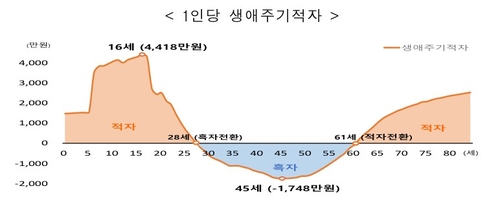
(Sejong=Yonhap Infomax) Jun Hyung Park –
South Koreans record a net financial surplus for only 33 years of their lives, specifically between the ages of 28 and 60, according to new data released by Statistics Korea on the 25th.
The data shows that the largest per capita deficit occurs at age 16, reaching 44.18 million won ($32,500), while the peak surplus is observed at age 45, amounting to 17.48 million won ($12,900).
The "2023 National Transfer Accounts" report, published by Statistics Korea, analyzes the flow of economic resources between age groups, focusing on the relationship between consumption and labor income over the life cycle.
As of 2023, total national consumption stood at 1,459.2 trillion won ($1.07 trillion), while labor income totaled 1,232.8 trillion won ($900 billion). The resulting life cycle deficit—the gap between consumption and labor income—amounted to 226.4 trillion won ($166.6 billion).
The working-age population (15–64 years) posted a surplus of 137.2 trillion won ($101.1 billion). In contrast, the youth segment (0–14 years) and the elderly (65 years and older) recorded deficits of 184.4 trillion won ($135.7 billion) and 179.2 trillion won ($131.9 billion), respectively.
On a per capita basis, the financial trajectory follows a three-stage pattern as people age: deficit → surplus → deficit. Individuals are in deficit from birth, enter surplus at age 28, and revert to deficit at age 61.
While the age of entering surplus has remained stable at 27–28 since 2010, the age of returning to deficit has gradually increased from 56 to 61, reflecting longer life expectancy and delayed retirement among older adults.
The largest per capita life cycle deficit is recorded at age 16 (44.18 million won), while the highest surplus is at age 45 (17.48 million won). Per capita consumption peaks at age 16 (44.18 million won), whereas labor income rises steadily after age 17, peaking at age 45 (44.33 million won) before declining.
Life cycle deficits are offset through public transfers, capital income, property income, and savings.
jhpark6@yna.co.kr
(End)
Copyright © Yonhap Infomax Unauthorized reproduction and redistribution prohibited.

